From The June 2017 Issue Of DRUM! Magazine | By Brian Stephens | Photography By Jimmy Hubbard
It reads like the next chapter in the saga of a hallowed classic rock outfit in the vein of Zeppelin, Aerosmith, and Sabbath. Mastodon, a major label band that’s circled the globe for the past 17 years, goes in to record its seventh studio album, Emperor Of Sand. At the helm is producer Brendan O’Brien, rock-and-roll royalty, responsible for some of the most popular albums from just about everybody’s favorite bands of the last three decades, including Soundgarden, Red Hot Chili Peppers, AC/DC, Bruce Springsteen, and Stone Temple Pilots.
Behind the recording console is engineer Tom Tapley, whose towering credits include Sugarland, Pearl Jam, Incubus, The Wallflowers, Indigo Girls, Earl Klugh, Velvet Revolver, and Destiny’s Child, among many more. Then there’s the studio itself, owned by genre-defining titans from another corner of the music industry, Christian music’s own Third Day. Opened in 2009, The Quarry has been the studio home base for that Grammy Award–winning band as well as scores of other artists across every imaginable musical genre.
Throw in the household name that is this band’s record label, Warner Bros., and it all adds up to quite a lavish undertaking. However, driving into the industrial complex where the studio is housed, weaving past small signs that read “Suzuki,” “Hyundai,” and “Philips/GE,” a different picture begins to emerge. It could be that all those famous name-drops, hefty résumés, and seasoned rock-star trappings mean something completely different to a hardworking, goal-oriented band like Mastodon.
It takes a lot of planning to pull off a project of this magnitude, but they’ve done it before. Drummer Brann Dailor makes it sound easy: “One day I just texted Brendan and asked, ‘Would you ever want to do another record with us?’ and he replied, ‘Hell yeah, I love Mastodon.’” They worked together on Mastodon’s 2009 album Crack The Skye, which has been their most successful release to date. “I think that Brendan brings a real sophistication to what we are trying to do,” Dailor continues. “Crack The Skye was such a benchmark record, such a leap forward.
“We could go with any of the big metal producers, and that’s what it would sound like: a metal record. I love metal. It’s what I grew up with and I’m a part of that tribe. But there’s so much more that we listen to and love and want to incorporate into our music. Brendan’s the perfect person to help bring in that King Crimson and Yes side of ourselves.”
Like the proverbial fly on the wall, we got the rare opportunity to sit in and observe how the creative team assembled all the pieces needed to lay down Dailor’s tricky parts — right down to the nitty-gritty. Here’s what we saw.
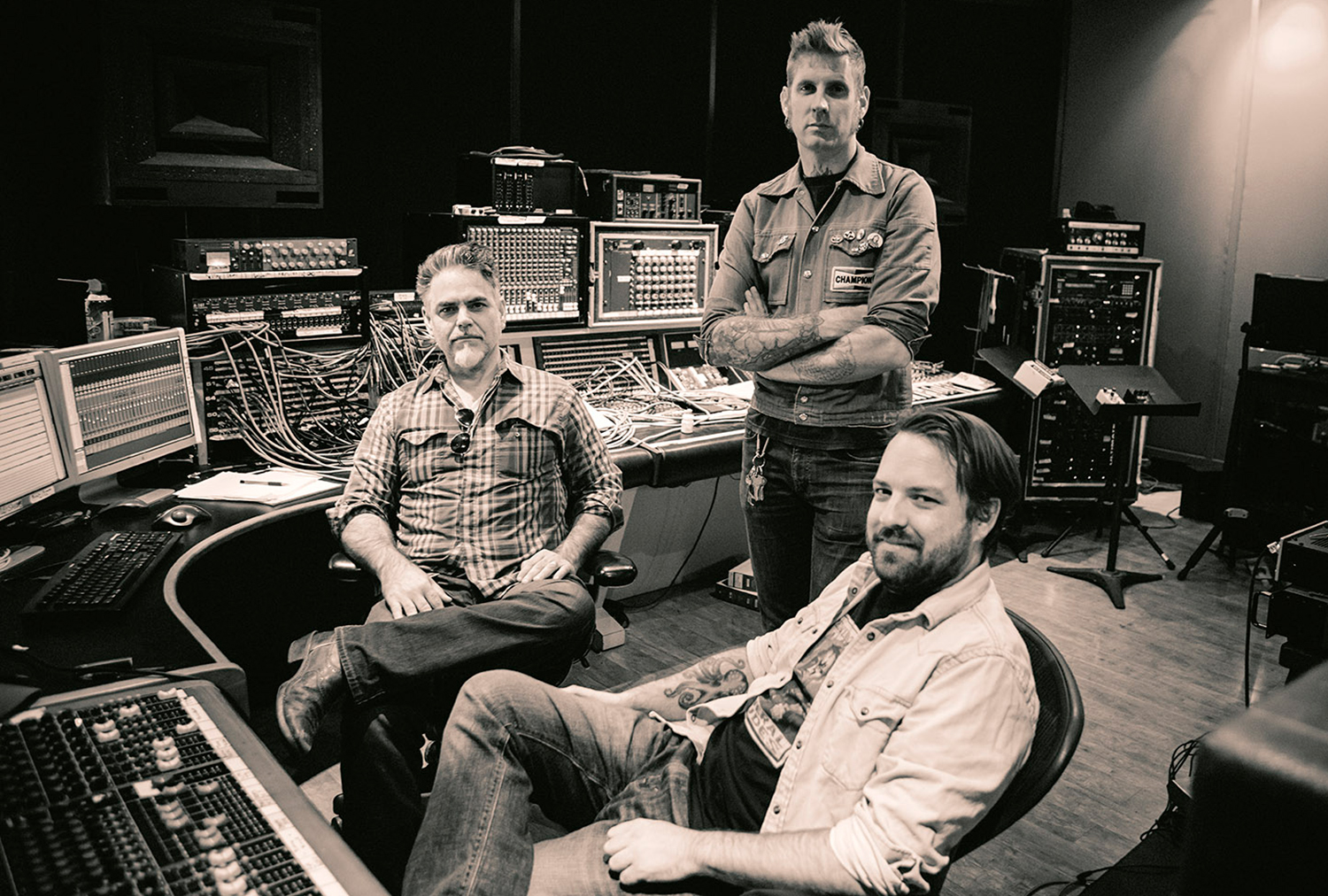
Studio dudes (left to right): Tapley, Dailor, and O’Brien’s right-hand man Billy Bowers chilling in the control room.
Inside The Space
When walking into The Quarry, located on the northern fringes of Metro Atlanta, Georgia, you aren’t met by a receptionist inside an opulent waiting room. The studio entrance, while decorated for maximum artist impact, is filled with music equipment, cases, cables, stands, and all sorts of indications that this is a place to work. There’s no large entourage of record company executives, managers, personal assistants, or ignorant bystanders. The only “boots on the ground” in this whole place are some bandmembers, their producer, his engineer-of-choice, a couple studio assistants, and photographer and close friend of the band, Jimmy Hubbard.
Ushered upstairs to the studio’s lounge area, we’re greeted by an opening snare fill and blistering groove, courtesy of Dailor. One of the bandmembers, guitarist Billy Kelliher, sits in a corner of the lounge behind a small audio workstation and speakers, editing drum tracks in Pro Tools. He’s cleaning up some of the work from the tracking sessions, making sure the editing phase’s “housekeeping” is taken care of properly. It seems as if every square inch of this studio is being used with a laser-like focus on getting work done quickly and efficiently.
We sit down at a large medieval table in the lounge’s dining area, next to a window overlooking the expansive three-story tracking room. In a far corner is Brann’s signature drum configuration flanked by studio isolation gobos. The drums have a perfect vantage point into this massive room filled with guitar amps, a grand piano, a B3 organ, and plenty of extra drum and cymbal options. Suspended high in the air, three enormous round scaffolds decorated with canvas scrims (the sort you would see on a Grateful Dead stage) adorn the walls. Coupled with large area rugs that look like they were borrowed from the last Black Crowes tour, the entire vibe of this studio tracking room is straight out of 1971.
It’s as if we’ve been transported back in time to that era where bands still made their albums standing in a circle, all playing together in real time. Many of their contemporaries make albums on laptops and in bedrooms these days, but Mastodon takes its cue from a completely different time and place. Engineer Tom Tapley says the studio’s live room “just sounds good. It’s big. It’s concrete. I mean, are you going to put Mastodon in a tiny, super dead room? I don’t think so.”

Dailor Arrived With Ideas
“A focal point in my conversation with Brendan and Tom initially was the drum sound on the first couple Heart albums: dry and tight, but with some beef and room sound,” Dailor explains. “I always go into every recording session with some idea in my head of what I want things to sound like. For this album, it was ‘Barracuda’ [from the Heart album Little Queen].”
That reference point led the team to make interesting and specific choices about drums, cymbals, and recording gear, which brings us to a dirty little secret about recording drums at this level (which, actually, isn’t much of a secret at all): When a band goes into the studio with a big budget, they have to deliver results — and that involves identifying the gear that will deliver the sounds needed for that particular session. In other words, endorsements don’t carry as much weight when the control room clock is ticking.
So, like countless drummers who came before him, Dailor made concessions in the studio that don’t actually contradict his undying love for the companies he endorses. That process began with an unusual request. Dailor explains, “Brendan asked, ‘Do you still have those Fibes toms?’” The producer was referring to a kit that Dailor had bought in his teens, which later became the sonic foundation for the drum tracks on Crack The Skye in 2009. The group then added a Gretsch 22″ x 16″ USA Custom bass drum rented from Avatar Events Group, a tour production and backline rental facility in Atlanta.
Avatar’s owner, drummer Kenny Cresswell, came along as the session’s drum tech. Atlanta’s version of Ross “The Drum Doctor” Garfield, Cresswell has provided services in the studio for such famous drummers as Morgan Rose, Jason Bonham, Steve Gorman, and Abe Laboriel, Jr. He set up the kit with all new heads and a first-round “ballpark” tuning, and then Dailor and Tapley took over, making subtle tweaks to get everything dialed in closer to the desired drum sound. “It takes a village!” Tapley quips.
Dailor and crew wanted a snare drum that was “big and heavy, but real tight,” according to the drummer. “That shotgun or that Glock sound. That crack with the body behind it.” After auditioning a number of options, everyone agreed Dailor would use a Dunnett titanium 14″ x 6.5″ as his primary snare for most of the tracking sessions. Otherwise, an arsenal of others, including a Dunnett bell brass snare and a cavalcade of assorted Tama models, rotated throughout the rest of the album.
Dailor remained true to his personal preference for Meinl cymbals, selecting mostly from the company’s Byzance line, because they provided more “finesse and warmth,” he says. “Something that isn’t going to [cut or be harsh]. Something classic, a thinner cymbal that washes nicely over everything and only pops out when it needs to. Something sort of jazzier that just lays right in there, where you need it to be.
“What I use live would be the Meinl MB20s, because they cut through those Marshalls [guitar amps] a little easier. I’ve got two walls of those and I’ve got two SVTs [bass amps] right next to each other, just crushing. Live, I need something that’s going to cut through all of that volume. But in the studio, you don’t really need that [sort of sound]. I knew, from working with Brendan last time, what he was looking for. He was going to lean toward something classic, darker. Meinl sent everything they make that had that warm sound for us to choose from.”
The standout cymbal surprise on these sessions was a Meinl 20″ Byzance Vintage Sand Ride/Benny Greb Signature ride. “I knew I was going to use that Benny Greb ride cymbal because I just love it. I have my own Signature ride cymbal, but I knew we wouldn’t use it most of the time because it wasn’t the right sound [for this album]. Brendan was particular about the cymbals. Day one, when we started tracking, he came out and listened to every cymbal.”
Turning to drumhead selection, Dailor threw a curveball by switching from his usual clear Evans G2-top/G1-bottom tom head choice to coated single-ply heads across the toms. Considering the heaviness of Mastodon’s music, you might wonder if a single-ply drumhead could withstand the aggressive, note-heavy assault of a metal drummer like Dailor. Engineer Tapley points out that “Brann’s so controlled [in his technique], it’s amazing! We only used one set of tom heads for the entire album!”
Miking Methods
It was time to match drums and cymbals with the right microphones, and Tapley knew exactly where to start. “I always set up my overheads and listen to them first,” Tapley explains. “If it doesn’t sound like a full drum kit in only the overheads, it’s broken. We don’t have to turn up the snare drum mike a bunch. It’s already in the overheads and it sounds great.”
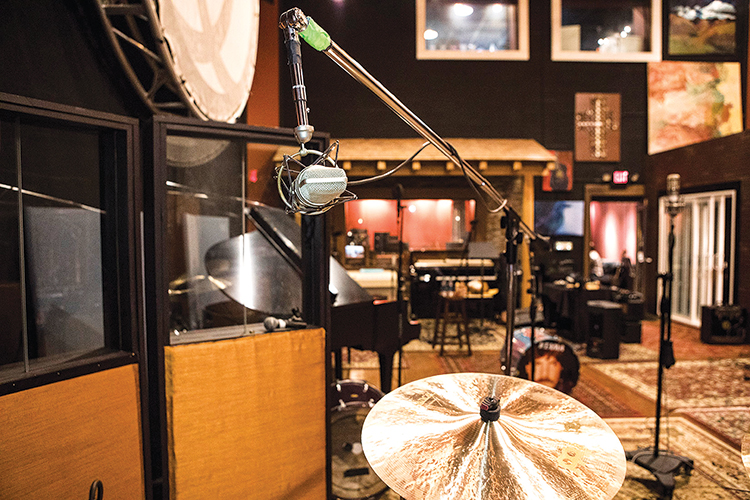
FIG. 1:Producer Brendan O’Brien brought his personal set of Neumann U67 large-diaphragm microphones to use as overheads, placed on either side of Dailor’s kit.
O’Brien brought along his own personal pair of vintage Neumann U67 large diaphragm condenser microphones to use as overheads (Fig. 1). “I just came out into the live room, put on headphones, and moved the overhead mikes around until it sounded great,” Tapley says. “It just has to be in phase and sound awesome. Otherwise, I could care less about exactly where they are placed [technically].”
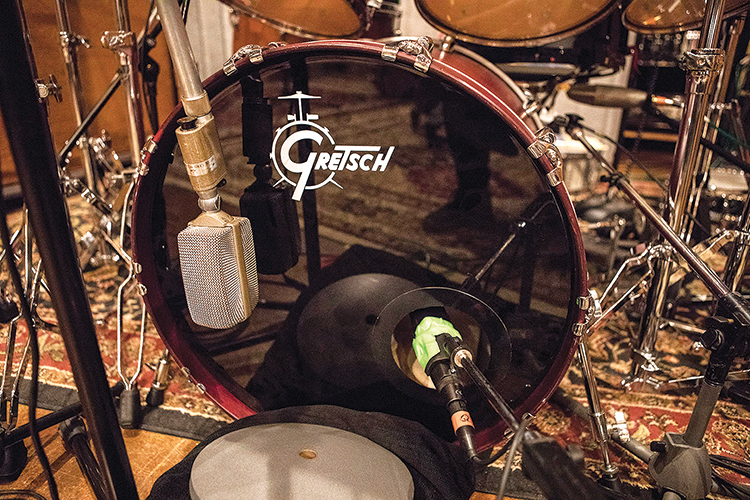
FIG. 2: Engineer Tom Tapley used two microphones to pick up the bass drum: an AKG D 30 outside the batter head and a Sennheiser MD 421 placed through a port in the front head.
Tapley is more strategic with bass drum microphone position, and always uses his own personal vintage AKG D 30 mike. “It goes with me everywhere. So the D 30 is my go-to on the outside and [a Sennheiser] MD 421 on the inside of the bass drum (Fig. 2). Sometimes I bury the 421, sometimes I don’t. I find that if I need more low-end, I just pull that 421 farther out of the drum.” Tapley EQ’ed each microphone at the recording console, then blended them together onto one track in the recorder.
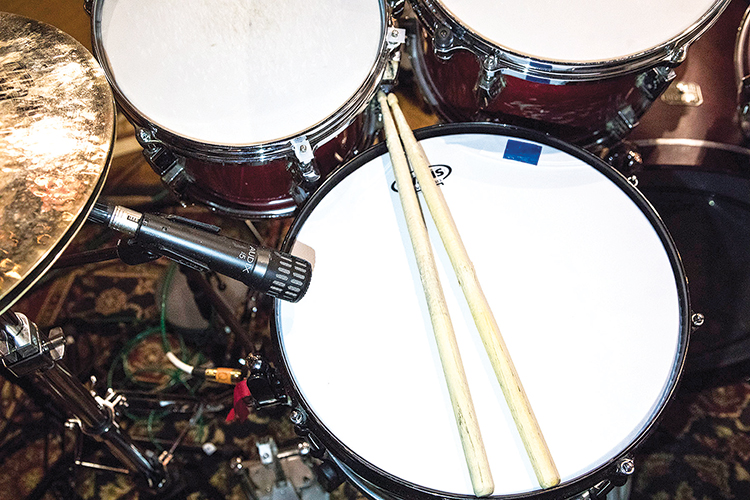
FIG. 3: A single Audix i5 dynamic microphone was placed with its capsule just above the hoop and pointing toward the batter head to pick up the snare drum.
The team chose an Audix i5 dynamic microphone for the snare drum instead of the seemingly ubiquitous Shure SM57 (Fig. 3). Why? According to Tapley, “It just sounded better that day.” And they agreed to use Audio-Technica ATM25 tom mikes (Fig. 4), which provide a tighter hypercardioid pattern. “You don’t have to EQ them,” Tapley says. “They go down to tape or hard disk great, and just sound awesome.”
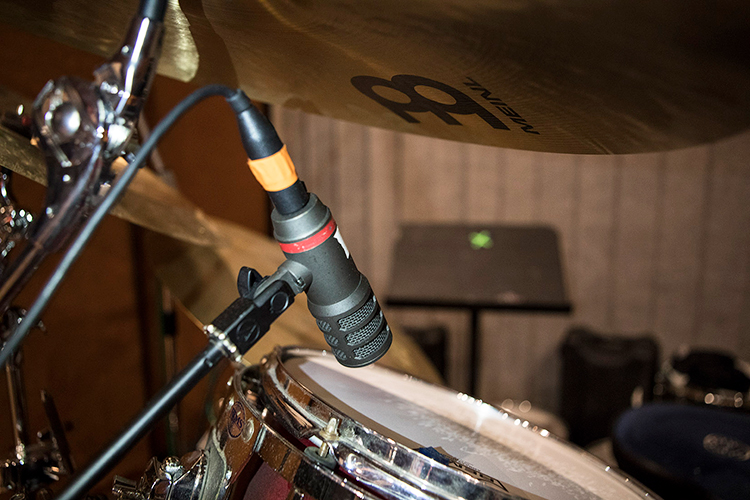
FIG. 4:
To take full advantage of the colossal live room, they placed a pair of Coles 4038 ribbon microphones about ten-to-twelve feet away from the drums, spread out a little wider than the kit’s footprint. In addition, they hung a Peluso 22 47 SE large diaphragm tube condenser microphone about seven-to-eight feet away, directly in front of the kit, to capture a pristine mono perspective of the whole drum set at a shorter distance.
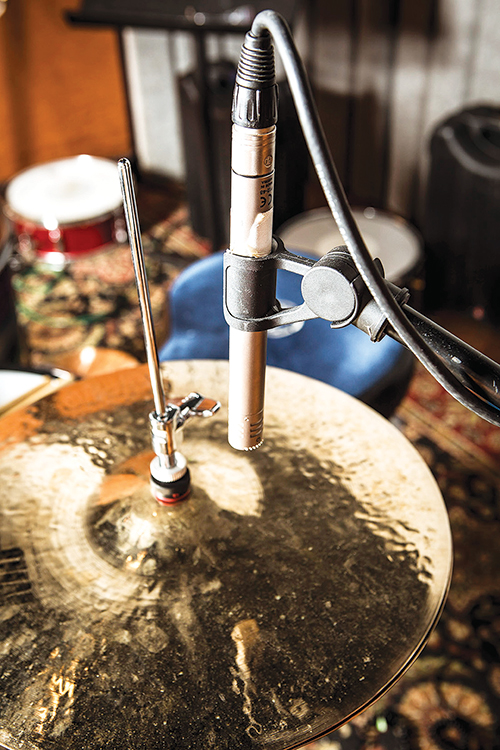
FIG. 5: AKG C 451 B microphones were used to capture parts of the kit that might have trouble competing with the rest of the band, such as the hi-hat.
AKG C 451 B spot mikes were positioned around the kit to capture specific instruments, like hi-hat (Fig. 5) and ride cymbal. They’ll come in handy during mix-down, to boost an instrument that has trouble cutting through Mastodon’s aggressive rhythm guitars or O’Brien’s lush add-on signature production elements. “Typically, those mikes are blended into the overhead mikes’ signal path,” Tapley says. “But in this case, we didn’t have enough [subgroup] busses [on the console] so the ride cymbal mike and hi-hat mikes went to their own tracks.”
Glancing around the live tracking room, we notice that Tapley has the entire band set up in a circle; so are the guitar amps, which sit exposed in the middle of the room. They aren’t isolated by gobos or stationed in small amp closets, which is customary, especially among metal bands. The enormous size of the room and the circular setup lets the band play through all of the songs together during the initial tracking phase, as if they were on stage. Recording live and in the round is not only an anomaly these days, but is also a testament to Mastodon’s commitment to deliver a connected, emotional performance in all of their studio recordings.
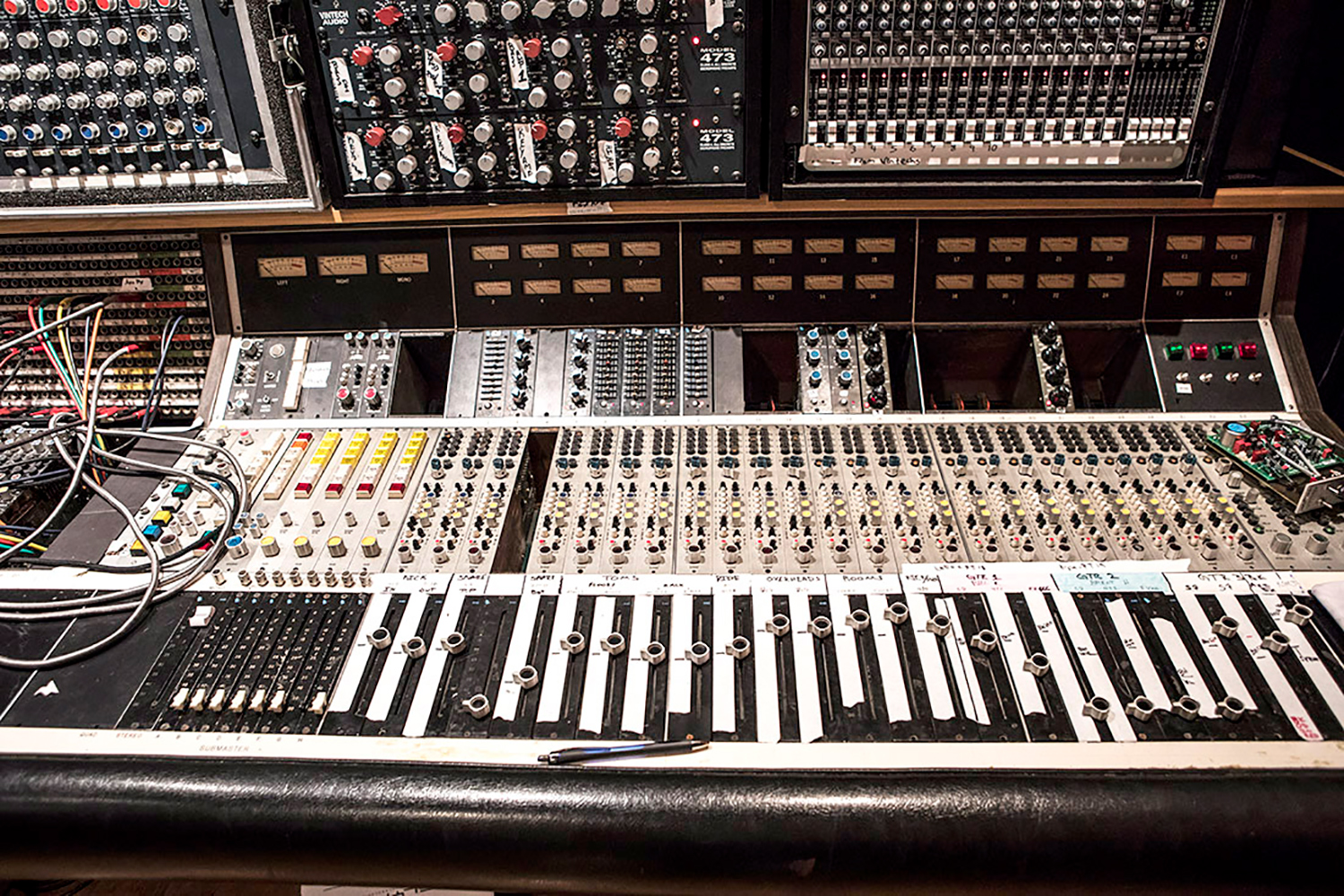
In The Control Room
A few steps away is the control room, where Tapley walks us through the setup. This centerpiece of The Quarry is big enough to double as someone’s four-car garage, and its slight A-frame ceiling makes the room feel open, relaxed, and inviting. Half of the space is lined with couches of various sizes and shapes, and the walls are covered in warm, colorful fabric. It’s no wonder that songwriters find this room to be a comfortable and inspiring place to work and create.
All drum microphones are run through The Quarry’s vintage API 2488 console’s mike preamps, except for the Peluso mono room mike, which travels though the famed Tube-Tech MP2A tube preamp before getting “squashed” through a vintage Urei 1176 Rev. F compressor. Overhead mikes were run through a Summit DCL-200 stereo tube compressor (“closest thing we had here to an LA-2A”) to shave off a little edginess from the drums’ transients and fatten up the overall drum sound.
Other than a little bit of surgical EQ on the kick drum mikes with a vintage ADR F769X-R Vocal Stressor, very little EQ was used in the drum tracking phase of this album. “I just want it to sound natural,” Dailor says. “I don’t want it to be triggered or sound-replaced. I don’t know where things [in metal music] got so metallic sounding and ‘clickity clackety.’ Maybe, that’s where my Bill Ward and classic rock influences come into play.”
Setup
Time is money, and these guys didn’t waste a penny — loading in Dailor’s gear, setting it up, and getting drum sounds in only one day. Once the drums were set up, tuned, and miked, the process of dialing up drum sounds was quick and painless, requiring only 60 to 90 minutes. “We’re ready to go fast,” Tapley says. “We haul ass, man! When [an artist] is waiting on us, especially when somebody’s excited to come in and record, if it takes us longer than that, then we’re not doing it right. The biggest challenge was the [microphone] phasing. Typically, we’re not running four toms. It’s usually one rack tom, one floor tom, and less cymbals, even. So getting the phase right when all of the mikes were pulled up is the biggest hurdle.”
In fact, unlike previous Mastodon releases, everything about the production of Emperor Of Sand was characterized by speed and efficiency. “This was fast!” Dailor exclaims. “I remember doing eight to ten versions [of drum takes] for previous albums, just trying to be safe. A week later, we’d still be tracking drums.” This time Dailor was able to record drum tracks for the entire album in just two days. “It’s so fun to make a record with Brendan. It’s fast! He’s just like [snaps his fingers] ‘Do you have an idea? Then do it!’ He wants to be prepared [to catch] lightning in a bottle.”
“We don’t playlist anything in Pro Tools,” Tapley says, referring to a feature that allows users to record multiple takes on a single track, to more easily comp together different performances into a single take afterward. “We print a click track first, usually with a Tama Rhythm Watch, and then immediately record [onto the master take]. If we need to punch or comp together a take, we do it against the [printed] click, so there’s no playlist. Nobody wants to see that.” Dailor adds, “Most of the punches were in places where there were drastic tempo changes. Maybe we’d decide that a middle part needed to be faster. So they would [record] that section and comp it in later.
“Brendan’s good at trimming the fat. He’ll just say, ‘We don’t need that part. Get it out of here!’ and you’re like, ‘Okay,’ because we trust him. At the end of the day, that’s what it’s all about: trust. And we like him as a person. So it’s like hanging out with a friend. Everybody’s telling stories and laughing, so you’re having fun making a record. Ninety percent of [a producer’s job] is being good with people. There’s a reason why some producers like Brendan rise to the top. You need have great ideas, but you also need to be able to work with people and develop that personal relationship.”
A part of that relationship was the producer’s trust in Dailor’s drum parts, which have always skirted the chasm that separates hardcore metal, progressive rock, and even (gasp!) jazz-fusion. “I want to be myself,” Dailor says. “There are enough drummers that lay it down and serve that song, and I do want to serve the song. It’s not all about me. It’s about the whole thing. But I want to incorporate the way that I play drums, because I have a certain style that people recognize. That’s how I play. There’s no way you can take that out of there. If I feel like it doesn’t have my feel or my fills, I’ll adjust that. I’ll say, ‘This is as reeled in as I’m going to go.’ I don’t want to make it about myself, but I feel that my fills and the things that I do are an integral part of what Mastodon is. I want everyone to be themselves, because I think that’s the special thing about our music.”
It’s A Wrap
With his drum tracks “in the can,” Dailor spends his time in the studio writing lyrics and vocal melodies. As the other Mastodon members layer additional instrumental tracks, Dailor and his bandmates begin to cull together the best vocal ideas, which they later “go out there and audition” for each other. The best ideas win. Once most of the song’s tracks are recorded, Dailor, O’Brien, and the whole team will spend a day overdubbing percussion and other assorted “ear candy” to fill out the production.
For anybody wondering how Emperor Of Sand is different from Mastodon’s previous albums, Dailor offers: “It’s fast and furious and that’s exciting. The vibe is quite different: tighter and heavier. I love running the heaviest version of ourselves through the Brendan filter.”
Mastodon’s Emperor Of Sand can be ordered from www.mastodonrocks.com/emperorofsand.
For information about The Quarry, go to thequarryrecording.wordpress.com.
Watch Drum Magazine’s Groove Analysis lesson on Brann Dailor from 2014, in which Nate Brown analyzes Dailor’s chops on Mastodon’s album Once More ‘Round The Sun.
